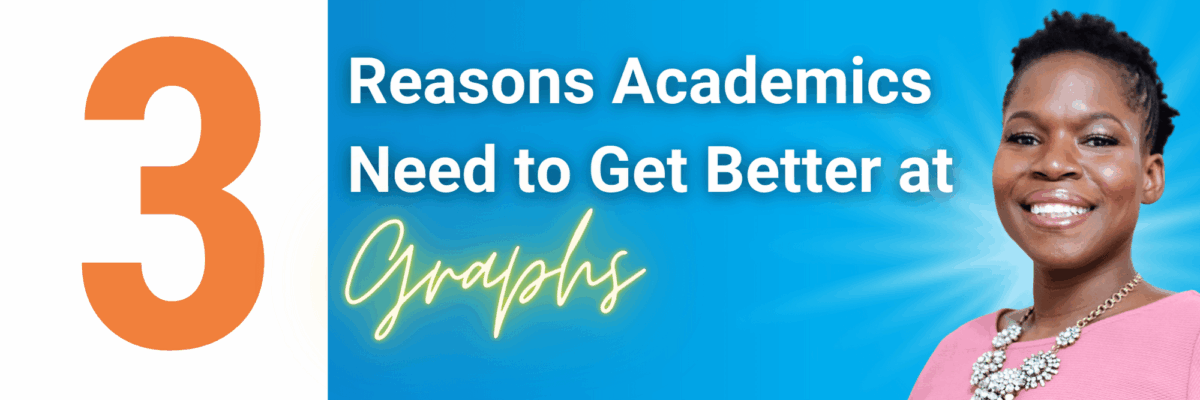3 Reasons Academics Need to Get Better at Graphs
This is one of the best worst graphs of all time.
It was published, no surprise, in an academic journal.
It used to be that mediocre data viz was acceptable for academics because journals had limitations on what they could do with color and page length.
Academics aren’t just writing for journal audiences anymore.
Scholars (and recovering scholars) are using their positions and platforms to bust out of the confines of a journal article and tell their stories to broader audiences – where high-quality data viz brings the audience to your yard.
If you want to change the world (even your small corner of it) with your data, you’ve gotta get better at data viz. The smart AND wise academics I know are learning better data viz for three specific reasons.
1. To Bring Public Attention to Social Issues
In our one-on-one data viz coaching program, The Evergreen Data Certification Program, I support Tiffany Green, PhD.
Her academic focus is on how social policies disproportionately impact Black families. This is the critical work it takes to dismantle the systems that perpetuate inequality.
Tiffany’s gotta get her data out to a bigger audience.
But if she stuck with the training academia gave her, she’d be part of the long (and sad) tradition of mediocre graphs that die inside the pages of a journal article that very few people ever read.
Tiffany’s got a larger mission: to help people better understand the disparate impact of “trendy” policies.
Here’s how she visualized abortion access in the United States:

This, my friends, is a spectrum display. It’s smart, cool, and beautiful (just like Tiffany). And it gets a lot more attention from a much bigger audience than a table buried on page 54 of a journal.
Tiffany had this to say:
I have to admit that I have been particularly proud of my spectrum displays.
As a Center for Public Health Law Research Fellow at Temple University, I’m working with an amazing group of legal epidemiologists and law students to map and understand the impacts of mandatory waiting and counseling laws on reproductive health disparities.
This spectrum display (and an earlier version of this data viz) always get amazing feedback from my colleagues and how impactful and cool they are and how useful they are for understanding these policies in a real-world context.
2. To Inform Policy
Did you know there’s a policy called Birth Cost Recovery that holds unmarried non-custodial fathers responsible for Medicaid childbirth costs? This is the kind of policy that, intentional or not, impacts Black families more than others.
And the set up in Wisconsin, where Tiffany is based, makes a perfect case for study. Tiffany’s clean and clear and well-titled line graph shows us that 80% of unmarried Black birthing people live in just two counties in the state.

Milwaukee and Dane County. And Dane suspended the Birth Cost Recovery program in January 2020. Folks, ring the bell, we have a natural experiment setup!
Tiffany’s perfectly positioned to study the impacts of this program and report her results to the policymakers responsible for change. And policymakers are approximately one billion times more likely to pay attention to Tiffany’s data when it looks this clean and clear.
3. To Get Funding
In fact, Tiffany applied for funding from the Wisconsin Partnership Panel to support her investigation into the Birth Cost Recovery program. When she was selected as a finalist (!) she had to prepare a pitch and relied on some of the lessons from The Evergreen Data Certification Program to build her deck.
Look at these slides:


People. These could have been boring dot point slides. But these sleek and engaging designs highlight Tiffany’s level of preparation and professionalism. She’s ready.
And guess what? She got the funding.
But you probably aren’t surprised. Tiffany knows how to tell her data story. She does it in a way that is obviously rooted in solid methods and also practical and understandable to those who aren’t head down in a journal.
If you’re as excited as I am to see where Tiffany goes, follow her on Twitter.
And if you want to learn how to be the very best at data visualization, like Tiffany, learn more about The Evergreen Data Certification Program. Tiffany said she’s happy to answer any questions from prospective students about her experience in the program, so slide into her DMs (with the admiration and respect she deserves).
She wanted me to pass the words along to you:
As my time in The Evergreen Data Certification Program comes to an end, it’s hard to put into words what an impact Stephanie has had on the way I view data visualization and its possibilities for my work and my career.
So many of the graphs we academics produce could have far greater impact with just a few small changes or a more intentional choice about how we display information. I can confidently say that I have a huge leg up on most folks I know when it comes to the effective display of information.
Thanks to Stephanie, this year has given me even more of a thirst for learning more. The Evergreen Data Certification Program is an investment but it will result in epic transformation if you do the work. (And Stephanie will make sure you do!)




